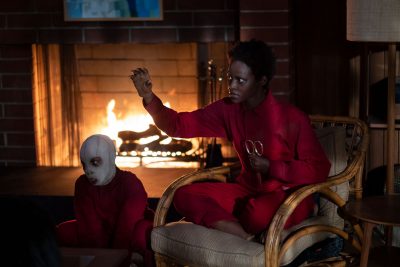
Jordan Peele’s film “Get Out” combined edge-of-your-seat thrills, cutting social satire and a tight, unified screenplay to form an astounding debut. While “Us,” Peele’s second feature, lacks the thematic cohesion of “Get Out,” it’s far more terrifying.
“Us” begins with Adelaide Wilson, played by Lupita Nyong’o, and her husband Gabe, played by Winston Duke, taking a summer vacation to Santa Cruz with their two children, Zora and Jason, played by Shahadi Wright Joseph and Evan Alex.
What was an idyllic getaway quickly turns into a nightmare when four figures, each a doppelgänger of a member of the Wilson family, appear on their driveway.
The home invasion sequence that follows demonstrates Peele’s ability to use cinematic language to terrify. The motionless figures are backlit with their long shadows extending toward the camera. This choice clouds the appearance of the doppelgängers in mystery and already feels like an apt addition to horror iconography.
As the doppelgängers, who call themselves “The Tethered,” invade the house, the audience adopts the perspective of the Wilson family. The camera’s closeness on Adelaide allows the audience to absorb every reaction and feel claustrophobic. Furthermore, only shadowy glimpses of the invaders are shown.
Put simply, Peele knows exactly where to put the camera and how to move it to make his audience feel terror.
Peele further demonstrates his knack for controlling the amount of information the audience is afforded. “Us” incrementally spoon-feeds its audience the particulars of the Wilson family’s plight, slow enough to maintain mystery yet quick enough to maintain engagement.
“Us” wears its horror-movie influences on its sleeve. The film alludes to the visuals of “The Shining,” “Jaws” and “A Nightmare on Elm Street” and bears plot similarities to “Invasion of the Body Snatchers” and “Funny Games.”
Still, “Us” has a unique voice due to Peele’s comedic flair.
The careful placement of humor within scares serves as a reminder of the connection between horror and comedy. Both elements build and release tension, create a series of expectations and deliver results to elicit a visceral reaction.
The comedic elements of “Us” never detract from the film’s overwhelming sense of dread, as they all originate from naturalistic reactions to fear.
Among the most frightening elements of “Us” are “The Tethered” themselves. Dressed in red coveralls and wielding golden scissors, each copy is a twisted echo of the original.
The aggressive rage of Gabe’s double contrasts with his own endearing goofiness. Similarly, Adelaide’s parental instincts are juxtaposed with the emotionless nature of her double, named Red.
Nyong’o, who plays both Adelaide and Red, embodies each character with such a distinction that it feels as if they’re performed by two different actresses.
Red has a strained, raspy voice and an uncanny physicality that makes her feel inhuman. Adelaide, in comparison, is effortlessly graceful, confident and dignified. Nyong’o’s dual performance is nothing short of a triumph.
Peele uses “Us” not as a vessel to examine race relations like he did with “Get Out,” but rather as a means to examine America itself. He alludes to the underbelly of the American dream and the relationship between the “haves” and “have-nots.”
In the film’s most loaded line, Gabe asks, “Who are you people?” to the Tethered. Red simply responds, “We’re Americans.”
Everyone who watches “Us” is bound to form their own interpretation of the film. One may see the movie as being predominantly about the American underclass — for every successful person there’s another just like them living in torment. Another may interpret the film as a commentary regarding an inability to see oneself as a cause of evil.
Peele endorses these varied interpretations of “Us” by providing an abundance of ambiguous details and metaphors that pile up during the film’s closing third. While all of these elements certainly allude to grand thematics, Peele has too much to say for the film to achieve the narrative elegance of “Get Out.”
If “Get Out” was a portioned, precisely made dish, “Us” is an all-you-can-eat buffet.
Undoubtedly, analyzing “Us” under a microscope will prove just as fun as digging through “Get Out” for hidden details. After all, Peele retains his gift for giving thematic purpose to every line of dialogue, costume choice and set design.
Even if the film becomes cluttered in its closing scenes, everything that comes before is an incredibly well-executed horror thrill ride.
With “Us,” Jordan Peele yet again proves that he’s one of the most exciting filmmakers of our generation.




